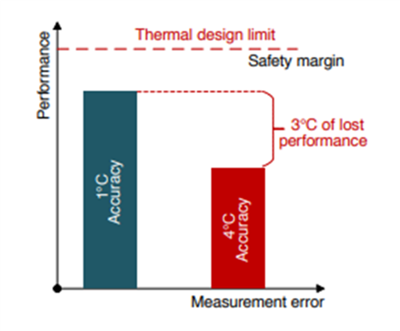SSZT398 october 2019 TMP235-Q1 , TMP390-Q1 , TMP451-Q1 , TMP61-Q1
Next-generation cars now come equipped with ever-more-complex infotainment and cluster systems. But the increased electronic content in modern vehicles consumes more energy, which generates more heat. Car dashboards are already exposed to solar loading and high temperatures as a result of cabin heating.
Due to the increased heat throughout infotainment and cluster systems, automakers must now overcome new thermal-management challenges. They need to offer a feature-rich and comfortable driving experience that appeals to customers while ensuring safe and reliable operation of the crucial functions these systems provide – all within a limited budget.
Figure 1 identifies various infotainment and cluster applications, each with their respective thermal problems.
 Figure 1 Infotainment and cluster
systems where thermal issues are a key concern
Figure 1 Infotainment and cluster
systems where thermal issues are a key concernSecuring overloaded microprocessors in automotive head units
Automotive head units have become the main control panel for infotainment systems, aggregating many different functions that were formerly dispersed throughout the car, serviced with various buttons. Such centralization makes this head unit the brain of the infotainment system, featuring important processing power via application processors that tend to heat up fast as the processing load increases.
TI designed the TMP451-Q1 for these remote sensing cases, with a ±1°C typical accuracy from -40°C to 125°C, for either the remote channel (the processor core) or locally (where the temperature sensor is placed), providing two temperature readings to the system. To limit the power consumption and thus self-heating that impacts temperature accuracy, the TMP451-Q1 operates with a low 1.7-V to 3.6-V power supply, consuming only 27 µA of operating current while making 0.0625 conversions per second.
The TMP451-Q1 is also designed for space-constrained head-unit PCB boards, thanks to its 8-pin, 2-mm-by-2-mm very very thin small outline no-lead package. There is a 2.5-mm-by-2.5-mm wettable flank version of this package as well that complies with the automatic optical inspection (AOI) process found in the automotive industry for fast solder verification on the electronic board.
The device has alert functions that serve as interrupts to modify system behavior when the temperature rises above a specific threshold. Two alert functions, THERM and ALERT/THERM2, provide more control of system thermal management.
As shown in Figure 2, setting a first interrupt (THERM2) to 85°C as a warning can trigger a fan, a cooling system or decrease the performance of the microprocessor to reduce the risk of overheating. The second interrupt (THERM), at 110°C, would actually shut down the system to save it from being damaged. For example, it could order the power supply to shut down and start a system reset until the temperature goes below the THERM hysteresis level.
 Figure 2 The THERM and THERM2 interrupt operations in the TMP451-Q1
Figure 2 The THERM and THERM2 interrupt operations in the TMP451-Q1Measuring system temperature accurately in reconfigurable clusters
Automotive instrument clusters provide crucial information such as speed, RPMs, fuel levels and oil temperature gauges – information that will affect a driver’s decision-making.
To obtain relevant temperature measurements, it is possible to place very small temperature sensors close to the microprocessor, which will help with reading accuracy. With a highly accurate reading, you can push the performance of the system closer to its thermal design limits or reduce system costs by choosing a microprocessor with lower specifications.
Indeed, while most processors have built-in temperature sensors, because of variations across wafers and other various lots, accuracy is only consistent at ±4°C. With such variance in the reading accuracy, you must account for a broader safety margin than one with a reading of ±1°C accuracy. In this case, the microprocessor would have 3°C of extra performance room without coming too close to the thermal design limit (see Figure 3).
 Figure 3 Enhancing system performance through high-accuracy thermal monitoring
Figure 3 Enhancing system performance through high-accuracy thermal monitoringThe TMP235-Q1 boasts ±0.5°C accuracy from -40°C to 150°C (Grade 0). The device has a very small footprint (2.00 mm by 1.25 mm – see Figure 4) and low power consumption.
 Figure 4 The TMP235-Q1 analog temperature sensor
Figure 4 The TMP235-Q1 analog temperature sensorProtecting systems and USB chargers from thermal damage
New USB chargers not only support USB Type A, but now USB Type-C™, which often includes power delivery capabilities from 60 W to 100 W. If you have multiple ports this wattage is multiplied, heating up dangerously and can potentially be hazardous. USB controller integrated circuits (ICs) typically have programmable cable droop compensation to help portable devices charge at an optimal current and voltage under heavy loads. Implementing a thermistor for intelligent thermal management can give an indication of the temperature to USB controllers and make them change their output current limit to lower levels in order to decrease the temperature.
Temperature switches can also protect systems against overtemperatures by sending an alert to the USB controller IC when the temperature crosses a certain threshold set by resistors, voltage or factory-programmed. This alert can bypass the microcontroller (MCU) to take a quicker, more direct decision. Depending on the temperature threshold, the MCU could also fail at lower temperatures than the temperature sensor. So there needs to be a protective system that can shut down this noncritical functionality of the car for passenger safety and to avoid thermal runaway. Furthermore, using a temperature switch is cost-competitive in comparison to a discrete implementation (Figure 5) because there’s no need to have extra circuitry like comparators and voltage references to detect the threshold.
 Figure 5 Discrete implementation of a temperature switch
Figure 5 Discrete implementation of a temperature switchThe TMP390-Q1 resistor programmable temperature switch covers the -40°C to +125°C temperature range with a ±3.0°C maximum accuracy. It has two channels that enable independent overtemperature (hot) and undertemperature (cold) detection simultaneously (see Figure 6). The TMP390-Q1 is also a low-power-consumption alternative to the thermistor, as it can be supplied with power from 1.62 to 5.5 V and consumes 0.5 µA at 25°C. The device offers the simplest thermal protection implementation and is also the most integrated as it includes a protection from both cold and heat in one chip.
 Figure 6 Undertemperature and Overtemperature protection with the TMP390-Q1
Figure 6 Undertemperature and Overtemperature protection with the TMP390-Q1There are various ways to deal with temperature monitoring and protection in infotainment systems, and many other aspects to consider. With the increasing number of features and displays in cars that are increasing the processing demands, ensuring thermal safety is critical in order to avoid accidents.
Additional resources
- Learn more about TI temperature sensors.
- Download “The Engineer’s Guide to Temperature Sensing” e-book.
- Read these application notes:
- Learn “How to protect control systems from thermal damage.”